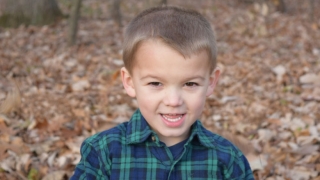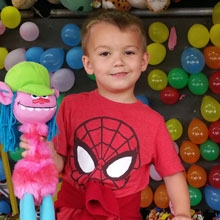Hypoplastic Left Heart Syndrome: Jeremy's Story
Published on
Published on
Jeremy was born with hypoplastic left heart syndrome, a severe heart defect. After a series of three reconstructive surgeries at Children’s Hospital of Philadelphia (CHOP), he’s now a funny, active, outgoing 5-year-old who loves to draw.
 At her 20-week ultrasound, Jessica received shocking news — the technician told her there was something wrong with her child’s heart. After an echocardiogram at a local hospital a few days later, she was given a more specific diagnosis. Her baby had hypoplastic left heart syndrome (HLHS), a severe heart defect in which the left side of the heart is underdeveloped. The cardiologist told her the baby would need special care at a hospital with expertise in pediatric heart surgery.
At her 20-week ultrasound, Jessica received shocking news — the technician told her there was something wrong with her child’s heart. After an echocardiogram at a local hospital a few days later, she was given a more specific diagnosis. Her baby had hypoplastic left heart syndrome (HLHS), a severe heart defect in which the left side of the heart is underdeveloped. The cardiologist told her the baby would need special care at a hospital with expertise in pediatric heart surgery.
Jessica researched options and made an appointment with the Fetal Heart Program at Children’s Hospital of Philadelphia (CHOP). There, accompanied by her boyfriend (now her husband), Frank, she underwent additional testing, which confirmed her baby’s diagnosis. The doctors explained that hypoplastic left heart syndrome is treated with a series of three reconstructive surgeries, the first of which is performed in the baby’s first week of life, the second is typically performed around four to six months of age, and the third when the child is 2 through 4.
Jessica and Frank were reeling from the news, but they had confidence in the team at CHOP. Just before Christmas, eight months into her pregnancy, Jessica moved into the Ronald McDonald House in Camden, NJ, to be close to CHOP. She was coming to the Hospital for regular appointments and testing, and she needed to be nearby in case she went into labor early. At one of these visits, just two days after her move into the city, Jessica’s medical team decided that she should deliver her baby early, three weeks before his due date.
Jeremy was born on Christmas Eve in the Garbose Family Special Delivery Unit, the first birth facility in a pediatric hospital designed for healthy mothers carrying babies with known birth defects. Moms can stay close, and babies are treated immediately after birth without having to be transported between hospitals.
As soon as Jeremy was born, his medical team, led by cardiologist Anita Szwast, MD, took him to the other part of the delivery room for examination and care. “After an hour, they brought him to me so I could hold him,” remembers Jessica. “Then they wheeled him to the Cardiac Intensive Care Unit (CICU). Later in the day I was able to see him.”
Jeremy was put on medication to keep the ductus arteriosus open. Then, when he was 4 days old, he had the first of the staged reconstructive procedures. Stage 1 or Norwood procedure, involves controlling blood flow with a surgically placed shunt and patches to prevent damage to the heart and lungs, while ensuring that enough blood is reaching the lungs to keep the child alive until the second stage. The procedure was performed by Thomas Spray, MD, Chief of the Division of Cardiothoracic Surgery, who would also do Jeremy’s other reconstructive surgeries. Jeremy was discharged on Jan. 11.
Jeremy received his nutrition through a nasogastric tube, and the team at CHOP taught Jessica and Frank how to provide the special care he needed. They measured his formula intake and weighed him every day. The Infant Single Ventricle Monitoring Program (ISVMP), a program that provides specialized care for high-risk infants during the time between two required heart repair procedures, followed him closely. Frank stayed home to care for Jeremy after Jessica returned to work.
Jeremy had the second of the staged procedures when he was 4 1/2 months old. The Glenn procedure redirected the flow of deoxygenated blood from the upper body to his lungs, bypassing his heart.
After the procedure, he had some complications, the most serious of which was superior vena cava syndrome (SVCS). The superior vena cava is a major vein that carries blood from the upper body to the heart, or, in Jeremy’s case, to the lungs. SVCS occurs when the vein is constricted or blocked. For Jeremy, this led to excessive pressure in his head, which became swollen.
After Jeremy healed from the surgery, interventional cardiologist Andrew Glatz, MD, performed a cardiac catheterization procedure to relieve the pressure. That corrected the problem.
When he was almost 3, Jeremy had the third and last of the planned reconstructive heart surgeries, the Fontan procedure. Following the surgery, he developed chylothorax, a condition in which lymphatic fluid leaks into the space between the lungs and the chest wall. This resolved after six weeks on a low-fat diet.
 Jessica and Frank were amazed at how much Jeremy’s condition improved after his third surgery.
Jessica and Frank were amazed at how much Jeremy’s condition improved after his third surgery.
Two months before the procedure, they had gone on a vacation cruise, and Jeremy wasn’t even able to walk from one cabin to the next. At home, he would sit on the couch and watch TV. He didn’t have the energy to run around the house.
Just three days after his surgery, he was walking down the hall outside his hospital room. And after he had fully recovered, he enjoyed running and going to the playground. The following spring, he participated in a soccer league.
Now, at 5, Jeremy enjoys T-ball, swimming and gymnastics. He is a talented artist, able to draw his favorite cartoon characters and different types of airplanes. He’s a funny, active, outgoing, helpful and thoughtful child. His preschool classmates are very impressed with his drawing skills, and turn to him when they want a picture of a fire truck or another favorite object.
Jessica and Frank enrolled Jeremy in CHOP’s Cardiac Kids Developmental Follow-up Program as an infant. In his annual visits with the program, he sees therapists and a neurologist as part of his cardiac care. The program was developed because of the connection between complex congenital heart disease and neurodevelopmental issues. Jessica and Frank have found the program extremely helpful, both for the extra therapy offered to Jeremy when he was younger, and for the guidance it provides now that he is in school.
“CHOP is our second home,” says Jessica.
“I feel very much at peace knowing that Jeremy is being cared for by the best.”